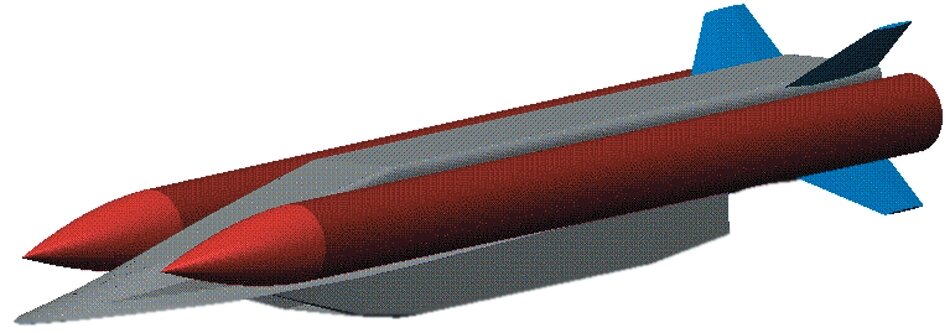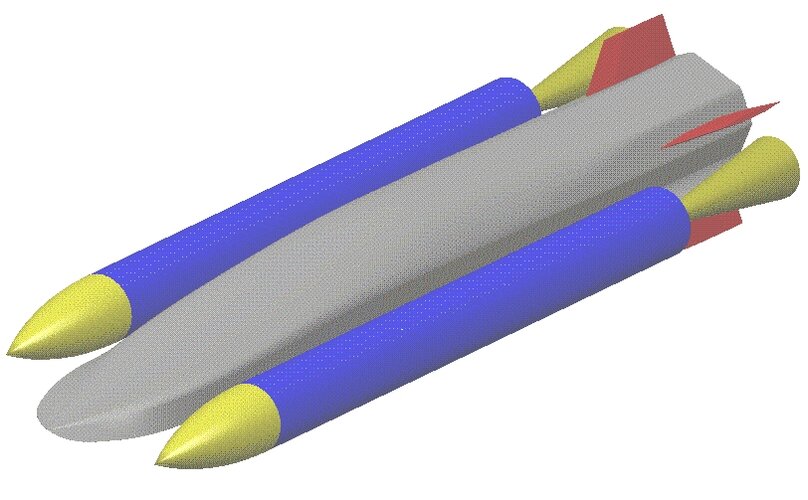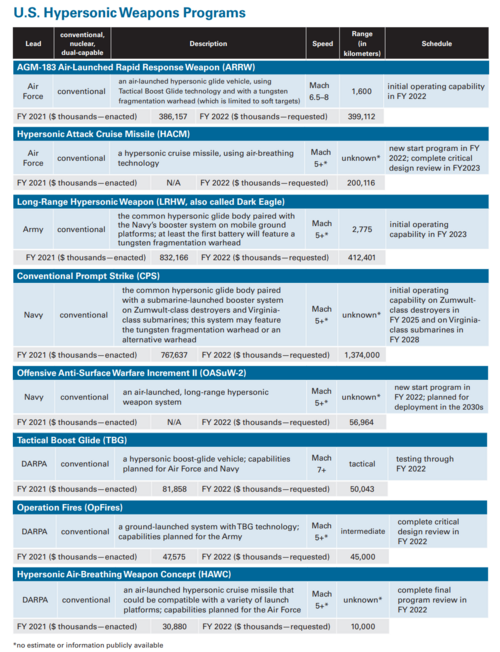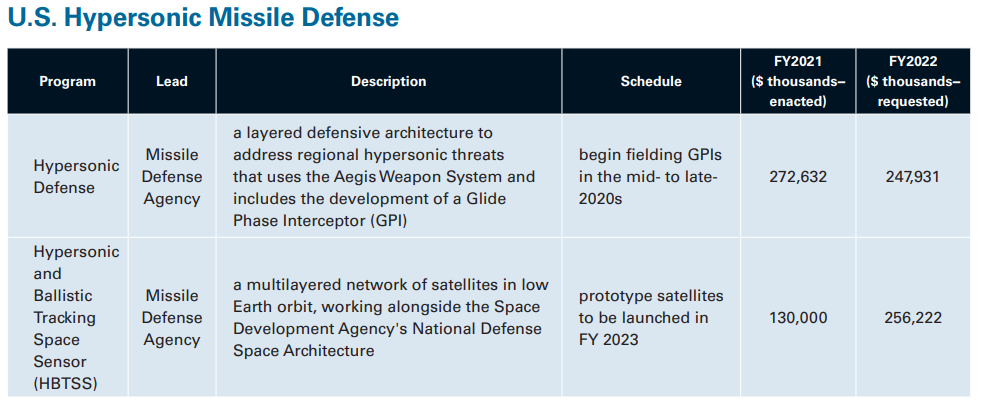You are using an out of date browser. It may not display this or other websites correctly.
You should upgrade or use an alternative browser.
You should upgrade or use an alternative browser.
Current US hypersonic weapons projects. (General)
- Thread starter Hanse
- Start date
- Joined
- 21 April 2009
- Messages
- 13,732
- Reaction score
- 7,616

Airborne Range Hawks enabling more hypersonic flight tests
The drones, part of a program called SkyRange, provide the Pentagon with a flexible, airborne testing infrastructure.
TAOG
I really should change my personal text
- Joined
- 7 October 2018
- Messages
- 108
- Reaction score
- 237
MPBD
An air launched, highly classified hypersonic program.
Two stage rocket (from GD's booster size table, MPBD is 28x 126 size, which may be the fisrt stage size and is simmilar to ARRW size. But MPBD has two stage), second stage motor with TVC acs. Seems like a big strike missile.
Also, development is at least begin from 2018, and still continous now. Raytheon seeked program director through 2022.11-2023.3.
Update:
Raytheon still seeking for MPBD director on 2023/8/30
An air launched, highly classified hypersonic program.
Two stage rocket (from GD's booster size table, MPBD is 28x 126 size, which may be the fisrt stage size and is simmilar to ARRW size. But MPBD has two stage), second stage motor with TVC acs. Seems like a big strike missile.
Also, development is at least begin from 2018, and still continous now. Raytheon seeked program director through 2022.11-2023.3.
Update:
Raytheon still seeking for MPBD director on 2023/8/30
Attachments
-
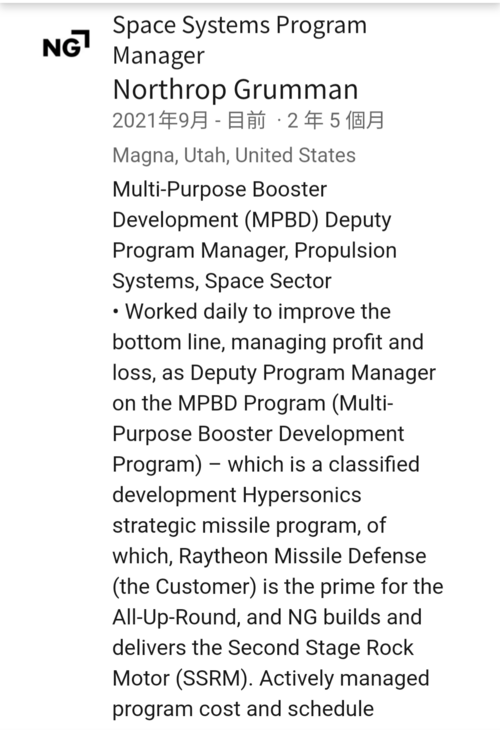 Screenshot_20240109-223446.png398.6 KB · Views: 57
Screenshot_20240109-223446.png398.6 KB · Views: 57 -
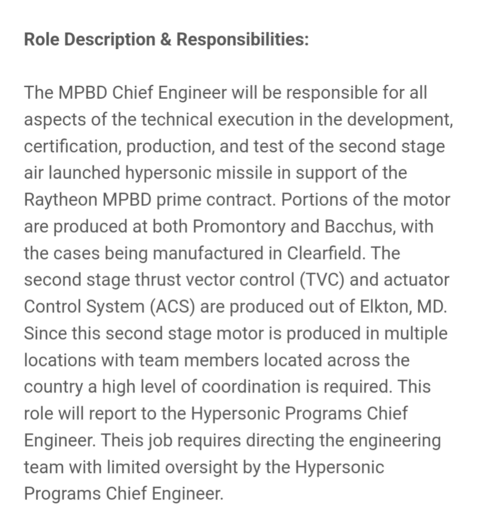 Screenshot_20240109-223533.png368.2 KB · Views: 39
Screenshot_20240109-223533.png368.2 KB · Views: 39 -
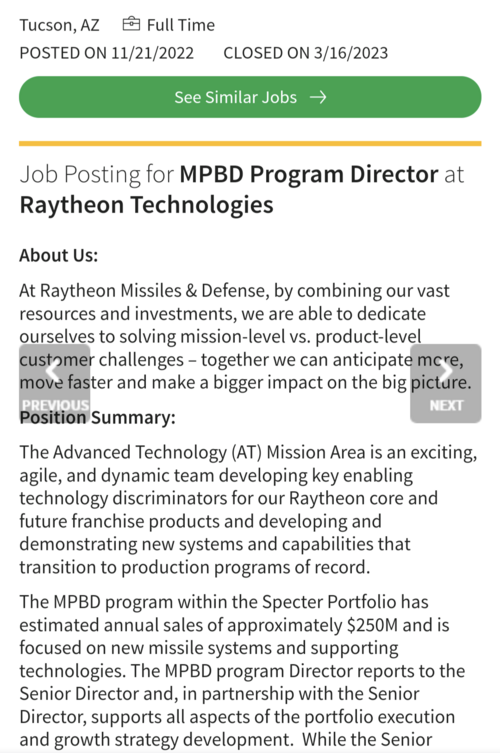 Screenshot_20240109-223632.png563.2 KB · Views: 35
Screenshot_20240109-223632.png563.2 KB · Views: 35 -
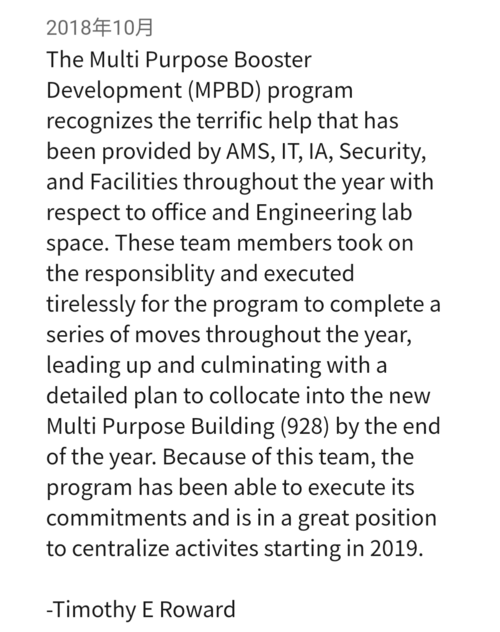 Screenshot_20240109-223654.png373.5 KB · Views: 41
Screenshot_20240109-223654.png373.5 KB · Views: 41 -
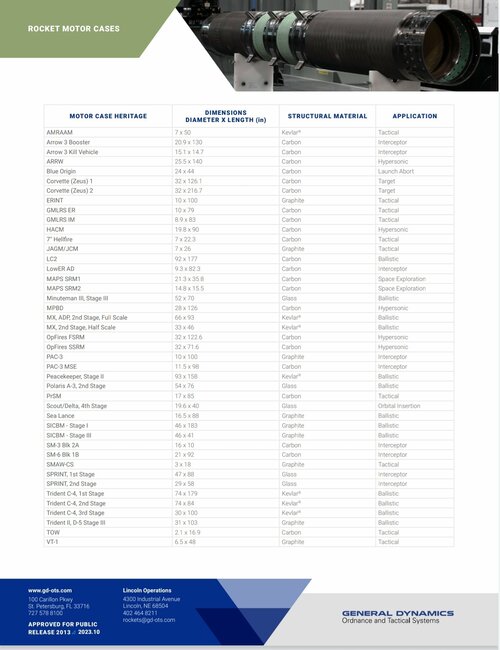 F3D1ABE3-42B5-4B56-A94E-2D7E7BD21E8B.jpeg232.7 KB · Views: 44
F3D1ABE3-42B5-4B56-A94E-2D7E7BD21E8B.jpeg232.7 KB · Views: 44 -
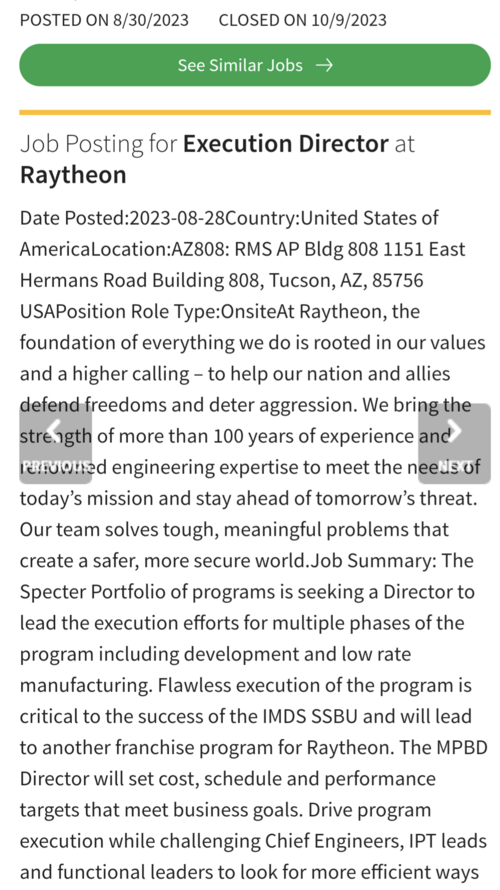 Screenshot_20240112-123237.png707.5 KB · Views: 25
Screenshot_20240112-123237.png707.5 KB · Views: 25
Last edited:
Any chance this is the now defunct HCSW program? I suppose the fact that there was a program director sought through March 2023 excludes that program. It seems odd there would need to be another boost/glide program on top of ARRW (and HCSW).
- Joined
- 21 April 2009
- Messages
- 13,732
- Reaction score
- 7,616
Lots of little nuggets of information in there.
The specifications of 10.5’ but is that only the second stage as described?
Also the identification of this system being a “strategic weapon” what range might this hint at?
The specifications of 10.5’ but is that only the second stage as described?
Also the identification of this system being a “strategic weapon” what range might this hint at?
Lots of little nuggets of information in there.
The specifications of 10.5’ but is that only the second stage as described?
Also the identification of this system being a “strategic weapon” what range might this hint at?
10.5 ' seems like a relatively short stack. Wasn't ARRW more in the 20' range? Also I thought "strategic" was generally reserved for nuclear weapons, but presumably not in this context. I cannot imagine there is a black nuclear missile program.
TAOG
I really should change my personal text
- Joined
- 7 October 2018
- Messages
- 108
- Reaction score
- 237
Hcsw contractor is lockheed,not RaytheonAny chance this is the now defunct HCSW program? I suppose the fact that there was a program director sought through March 2023 excludes that program. It seems odd there would need to be another boost/glide program on top of ARRW (and HCSW).
TAOG
I really should change my personal text
- Joined
- 7 October 2018
- Messages
- 108
- Reaction score
- 237
Where is the 10.5 information? GD booster table describe MPBD as 28 x 126 size, which may refer to the first stage, but i did not found any second stage information.Lots of little nuggets of information in there.
The specifications of 10.5’ but is that only the second stage as described?
Also the identification of this system being a “strategic weapon” what range might this hint at?
Last edited:
- Joined
- 21 April 2009
- Messages
- 13,732
- Reaction score
- 7,616
126” / 12 = 10.5ft. I’m assuming it’s the second stage cause that appears to be what they are specifically working on.Where is the 10.5 information? GD booster table describe MPBD as 28 x 126 size, which may refer to the first stage, but i did not found any second stage information.
Some of these weapons are called “tactical” so again I am just assuming strategic means something different most likely long range.
Last edited:
aonestudio
I really should change my personal text
- Joined
- 11 March 2018
- Messages
- 2,962
- Reaction score
- 7,475
RTX completes technical review for prototype of U.S. Navy's HALO missile
/PRNewswire/ -- Raytheon, an RTX (NYSE: RTX) business, has successfully completed a technical review and a seamless prototype fit-check in phase one of the U.S....
Is the HALO missile a clean sheet design or the modification of an existing missile?
I don’t think that we have any information one way or another, but the USN’s unique requirements almost certainly mean it is a new design. Outside HACM, what is there to base it on?
dark sidius
ACCESS: Top Secret
- Joined
- 1 August 2008
- Messages
- 1,193
- Reaction score
- 1,066
What about the SR-72 ? or Mayhem project ?
What about the SR-72 ? or Mayhem project ?
Both of those are reusable systems that likely would not make for cost effective disposable platforms. The biggest problem with an X-51/HAWC/HACM solution is the length of the stack. CV weapon elevators are limited to 15 feet. So a simple solid rocket boost to scramjet speed is impractical length wise. An integral booster also will not be possible with the wedge shaped combustion chamber of a waverider. My guess is that some kind of multimode engine (ramjet/scramjet) with a lower ignition speed and a cylindrical combustion chamber allowing for an integrated booster will be used to create a shorter stack. Something like HiFly would probably fit the bill.
- Joined
- 1 April 2006
- Messages
- 11,364
- Reaction score
- 10,149
Both of those are reusable systems that likely would not make for cost effective disposable platforms. The biggest problem with an X-51/HAWC/HACM solution is the length of the stack.
Attachments
Forest Green
ACCESS: Above Top Secret
- Joined
- 11 June 2019
- Messages
- 9,415
- Reaction score
- 17,153
The $3.8 billion covers efforts within the Army,Air Force, and Navy as they each pursue hypersonicweapon prototypes, some with ranges exceeding 3,000km.
Forest Green
ACCESS: Above Top Secret
- Joined
- 11 June 2019
- Messages
- 9,415
- Reaction score
- 17,153

The US is failing to quickly field hypersonic missile defense
Opinion: If Washington does not act quickly to expedite the Pentagon’s fielding of hypersonic missile defense capabilities, deterrence may fail in the Pacific.
Forest Green
ACCESS: Above Top Secret
- Joined
- 11 June 2019
- Messages
- 9,415
- Reaction score
- 17,153
- Joined
- 21 April 2009
- Messages
- 13,732
- Reaction score
- 7,616
Given Sentinel problems the US should develop a max range IRBM on a mobile launcher that can carry a missile heavy enough to also, oops by accident, carry a single warhead ICBM from conus.
Last edited:
Forest Green
ACCESS: Above Top Secret
- Joined
- 11 June 2019
- Messages
- 9,415
- Reaction score
- 17,153
I don't know how they can have a 37% cost increase when they haven't even done anything yet. Did they forget to factor in reading newspaper on the toilet time or something?
Interesting takeouts:
1. OASuW-2 (Offensive Anti-Surface Warfare Increment II) - is that just going to be HACM?
2. CPS - sea-launched LRHW?
3. TBG - the warhead for ARRW and LRHW? But range is described as tactical? PrSM warhead for the future?
4. HAWC - longer range version of HACM?
HALO is the OASuW 2 program. It will definitely have a different requirement and propulsion stack than HACM, because HACMs length makes it incompatible with CV weapon elevators. The USN also likely has very different operational requirements; HACM is not explicitly an anti ship weapon and it remains to be seen if it will have that capability.
CPS and LRHW use the same all up round, optimized for naval underwater launch, so yes.
Tactical Boost Glide was a DARPA program. It uses a winged glider over very long ranges - tactical in this reading just means non nuclear. The glider from this program was adopted for the USAF ARRW program of record. CPS/LRHW use a modified version of the SWERVE biconical glider from the 80s (lower development risk), as did the USAF HCSW program (since canceled). PrSM is not a hypersonic program and has nothing to do with any of the above.
HAWC was a DARPA demonstrator program whose data informed HACM and other projects. It is being continued as MOHAWC. It is not a weapons program, though Raytheon has stated some parts will directly be lifted from it to build HACM.
Last edited:
Given Sentinel problems the US should develop a max range IRBM on a mobile launcher that can carry a missile heavy enough to also, oops by accident, carry a single warhead ICBM from conus.
That would be a new ICBM and it would have all of the same infrastructure problems of sentinel. The missile itself is not particularly problematic.
Forest Green
ACCESS: Above Top Secret
- Joined
- 11 June 2019
- Messages
- 9,415
- Reaction score
- 17,153
So the LRHW/CPS don't even have asymmetric glide vehicles?Tactical Boost Glide was a DARPA program. It uses a winged glider over very long ranges - tactical in this reading just means non nuclear. The glider from this program was adopted for the USAF ARRW program of record. CPS/LRHW use a modified version of the SWERVE biconical glider from the 80s (lower development risk), as did the USAF HCSW program (since canceled). PrSM is not a hypersonic program and has nothing to do with any of the above.
So the LRHW/CPS don't even have asymmetric glide vehicles?
No, old school cylindrical design to expedite their introduction. Perhaps future generations will adopt a different glider but the AUPs will use a less aerodynamically efficient biconical design with an increased angle of attack. It was probably a sound choice that derisked the programs, along with both services adopting the same AUP customized to the most challenging launch environment (subsurface).
- Joined
- 21 April 2009
- Messages
- 13,732
- Reaction score
- 7,616
But you’re now avoiding those “infrastructure problems” with a mobile missile.That would be a new ICBM and it would have all of the same infrastructure problems of sentinel. The missile itself is not particularly problematic.
My tongue in cheek comment notwithstanding and to return to reality, in today’s America forty years after Midgetman, the media and public hysteria around a “mobile nuke” means “it ain’t gonna happen”.
But you’re now avoiding those “infrastructure problems” with a mobile missile.
My tongue in cheek comment notwithstanding and to return to reality, in today’s America forty years after Midgetman, the media and public hysteria around a “mobile nuke” means “it ain’t gonna happen”.
Mobile missiles still need bases and communications. All that it means is that you communications must be wireless and thus capable of interception or jamming. The communication system will have to accommodate that. I’m not sure what the exact plan is for Sentinel but MM3 silos are hard wired.
Mobile nukes are a non starter for political and practical reasons already discussed in other threads.
dark sidius
ACCESS: Top Secret
- Joined
- 1 August 2008
- Messages
- 1,193
- Reaction score
- 1,066
Mayhem program ?Interesting takeouts:
1. OASuW-2 (Offensive Anti-Surface Warfare Increment II) - is that just going to be HACM?
2. CPS - sea-launched LRHW?
3. TBG - the warhead for ARRW and LRHW? But range is described as tactical? PrSM warhead for the future?
4. HAWC - longer range version of HACM?
View attachment 717824
View attachment 717825
- Joined
- 21 April 2009
- Messages
- 13,732
- Reaction score
- 7,616
Yes see the post you quoted.Mobile missiles still need bases and communications. All that it means is that you communications must be wireless and thus capable of interception or jamming. The communication system will have to accommodate that. I’m not sure what the exact plan is for Sentinel but MM3 silos are hard wired.
Mobile nukes are a non starter for political and practical reasons already discussed in other threads.
Forest Green
ACCESS: Above Top Secret
- Joined
- 11 June 2019
- Messages
- 9,415
- Reaction score
- 17,153
That's a spy drone so not actually a weapon in itself I think.Mayhem program ?
- Joined
- 21 April 2009
- Messages
- 13,732
- Reaction score
- 7,616

RTX Completes Technical Review for Prototype of US Navy's Ha
--High-speed, long-range missile will provide greater anti-surface warfare capability
- Joined
- 21 April 2009
- Messages
- 13,732
- Reaction score
- 7,616

Limited test infrastructure, data shortages plague Air Force hypersonics program
A lack of available infrastructure and insufficient means to collect data has impacted the Air Force’s testing campaign for the Air-launched Rapid Response Weapon (ARRW).
- Joined
- 31 December 2006
- Messages
- 802
- Reaction score
- 363
MAYHEM getting the axe:
 aviationweek.com
aviationweek.com
AFRL Cuts Back Hypersonic Mayhem Demonstrator Plan | Aviation Week Network
The U.S. AFRL has decided to wind down its ambitious air-breathing hypersonic Mayhem development program, citing insufficient operational demand.
- Joined
- 3 June 2011
- Messages
- 18,302
- Reaction score
- 12,122
Of course. "Insufficient operational demand" my ass.MAYHEM getting the axe:
AFRL Cuts Back Hypersonic Mayhem Demonstrator Plan | Aviation Week Network
The U.S. AFRL has decided to wind down its ambitious air-breathing hypersonic Mayhem development program, citing insufficient operational demand.aviationweek.com
Scott Kenny
ACCESS: USAP
- Joined
- 15 May 2023
- Messages
- 11,413
- Reaction score
- 13,898
!!!
I was not expecting to see those rocket dimensions in a manufacturer's advertising document! At least not the strategic ones.
Doubt that it's much wider than a triple ejector rack with 1000lb bombs.It could probably be done, but there are disadvantages to a side by side arrangement. I doubt that is the direction the USN is going for; it still has to be carried by a tactical aircraft.
dark sidius
ACCESS: Top Secret
- Joined
- 1 August 2008
- Messages
- 1,193
- Reaction score
- 1,066
What are you thinking about the real reason why ?Of course. "Insufficient operational demand" my ass.
Last edited:
dark sidius
ACCESS: Top Secret
- Joined
- 1 August 2008
- Messages
- 1,193
- Reaction score
- 1,066
There will never be a reusable hypersonic system at each time it is cancel...MAYHEM getting the axe:
AFRL Cuts Back Hypersonic Mayhem Demonstrator Plan | Aviation Week Network
The U.S. AFRL has decided to wind down its ambitious air-breathing hypersonic Mayhem development program, citing insufficient operational demand.aviationweek.com
“Insufficient operational demand” or in short “sour grapes”Of course. "Insufficient operational demand" my ass.
dark sidius
ACCESS: Top Secret
- Joined
- 1 August 2008
- Messages
- 1,193
- Reaction score
- 1,066
What mean sour grapes ?“Insufficient operational demand” or in short “sour grapes”
Similar threads
-
Lockheed Martin AGM-183 Air-Launched Rapid Response Weapon (ARRW)
- Started by Moose
- Replies: 667
-
-
China DF-17 hypersonic boost-glide missile carrier
- Started by antigravite
- Replies: 41
-
-

